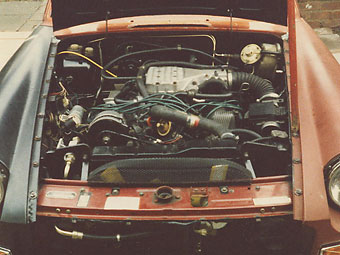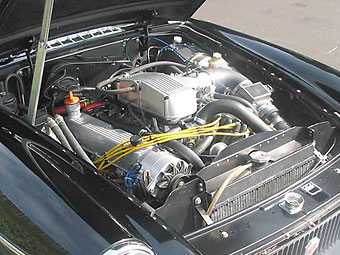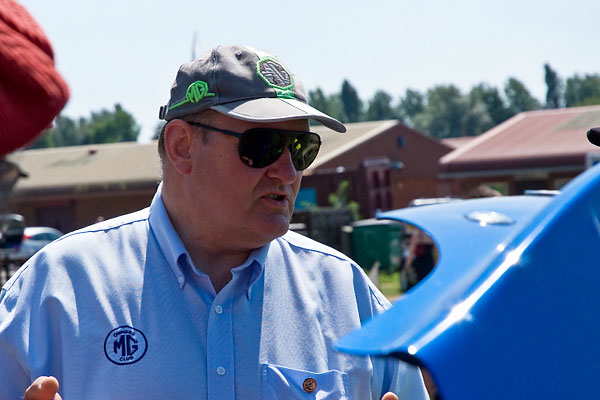 �
�

� Rover Airflow Meter (left) and Rover Hot-Wire (right) EFI Installations�
Fuel Injection, Not Such A Black Art
� � as published in MG V-8 Newsletter, Volume V Issue 2, August 1997�� by Roger Parker�
� Editor Kurt Schley noted: Roger Parker is the MG V-8 Representative for the MG Car Club (UK), � has authored dozens of articles pertaining to the V-8 conversions, and is a regular � contributor to "The MG V-8 Newsletter".�
�
�
Wherever you are in the world it's almost certain that many of the cars around �
you will now have engines controlled by fuel injection or fuel engine management �
systems. We probably drive these around without giving them a second thought, �
and the reliability of current systems means that you don't have to worry what �
is happening under the hood.�
�
When these systems were first introduced, they were regarded as something of a �
black art, and anything that happened to the engine was immediately the fault �
of the "injection" or "brain", when often it would have been something simple �
like too many miles on a set of spark plugs. The problem is that when you open �
the hood and you are confronted by a mass of wires, pipes and other bits, which �
often completely hide the engine, you feel like simply shutting it all up again �
and giving the job to "someone who knows". This has meant that the black art �
name has remained.�
�
If you take the time to study how a simple and basic engine management system �
works, and then fit in all of the extra bits which provide the extra controls �
for this and that, it is amazing how straightforward most systems really are. �
Even when you compare different manufacturer's systems it soon becomes quite �
easy to understand where each part is and what it does.�
�
Understanding this subject is greatly assisted if the system is split into �
three separate sections: (1.) fuel flowing components, (2.) air flowing �
components and (3.) control components. By studying the system this way the �
operation of each section can be understood very much easier. Then only the �
interaction between each section needs understanding to enable the whole to �
be understood.�
�
Now that you have an understanding of the system you can commence to install �
it. Modification of any MGB V8 from a carburetor to injection is extensive �
but well worth the effort. Briefly, the conversion route should go something �
like this: �
Fuel flowing components
��
Here we have to modify or change virtually every part of the MG. system which �
carries fuel. We must also take on board the fact that a fuel injection system �
moves very high volumes of fuel at very high pressure, far, far, greater than �
any of the original carburetor set-ups. Consequently, every part of the fuel �
system has to be designed for such operation and assembled to a very high standard.�
�
Rover's injected engines rely on an uninterrupted supply of perfectly clean fuel �
at a given pressure, usually between 1.8 and 2.5 bar (28 - 36 psi), although the �
fuel pump can deliver over 4 bar (60 psi). To install this in an MGB requires �
considerable changes. The fuel tank has to be internally modified with an �
additional internal reservoir so that fuel surge doesn't uncover the fuel pick �
up and cause the engine to cut out. This is known as a swirl pot and carries both �
a large bore fuel pick up and a return from the engine (Spill return)�
�
Alternatively an external swirl pot can be fabricated but this involves more �
complication, with feeding one tank from the other and needing extra space to �
fit it Fortunately, many specialists are now quite familiar with the process of �
fitting a swirl pot in fuel tanks not previously so endowed, and at quite reasonable �
prices. The other alternative is obviously to use the tank from the RV8 as �
this has all the required modifications for injection, as well the extra �
fittings for the evaporative loss systems, which retain all fuel vapors within �
the fuel system. (If the goal is to have a full 3 way closed loop catalyst �
system then this is the tank to use, along with a charcoal canister.)�
�
Next in line is a pre-filter which helps give the fuel pump a greater life �
expectancy. This is fitted in the fuel line before the fuel pump. The pump to �
use is one specifically designed to deliver the required volumes and pressure. �
To this end an external Bosch pump, as found on the RV8, Maestro/Montego EFI �
(and Turbo) models, Rover Vitesse (pre 1989, 26 and V8), and a myriad of other �
Bosch injected cars can be used. Next in line is the most important filter which �
saves you ruining 80 pound a time injectors! This filter has to be specifically �
for a fuel injection set up as it will have to withstand those high pressures.�
�
Fuel line bore can be the same as the original MGB, which is a quarter inch (6mm), �
any less can cause strain on the pump. ALL flexible hoses must be designed for �
injection systems and not of the cheap braided type often found in motor shops. �
There needs to be two separate pipe runs between the front and rear, one for the �
feed and one for spill return. Mounting these where the original pipe runs is �
probably the best route. In the engine bay the fuel feed will pass to the fuel rail �
above the left hand bank, and the fuel return will pass above the other bank.�
Air Flowing Components
�� Modifications vary, depending on which variation of the system you are using, � whether it is: (1.) an Airflow Meter System (flap type of meter) or the early � Australian/Federal SD1's, which had very compact manifold castings. These were � two piece units, with the plenum being flat and triangular shaped. (2.) The � same Airflow Meter System fitted to a high efficiency manifold, and which was � seen first in the V8 Vitesse and later the Range Rover. This time the manifold � was a three piece assembly, about 3.5" taller than the earlier system with a � characteristic ribbed and domed top. (The Twin Plenum Vitesse used a similar � system with a twin throttle design.) Or (3.), the same high efficiency manifold � fitted with the Hot Wire system, (from 1989 with no moving parts in the meter) � which fueled 3.5, 3.9 and 4.2 litre engines.�
��
Enjoying this article? Our magazine is funded through the generous support of readers like you!
�
To contribute to our operating budget, please click here and follow the instructions.
�
(Suggested contribution is twenty bucks per year. Feel free to give more!)�
�
Most recently the new Range Rover saw the introduction of the GEMS 8 fully digital �
total engine management system which for all practical purposes can't be retro �
fitted to earlier engines. The latest engines, designated 4.0 and 4.6 litre to �
avoid confusion with earlier engine capacities, are seriously reworked and few �
parts are interchangeable.�
�
Whatever system is chosen the biggest problem to overcome is one of hood clearance. �
Quite simply only the very early system has any chance of fitting under without �
mods, and only then if the engine is mounted as per the original factory V8's or �
RV8's. (Even then production variations can cause problems!) The early systems �
(Federal two piece manifold systems) may fit without modification, but if not they �
can easily be modified by having a little metal removed from the plenum chamber, �
where it joins the manifold. Up to 1" can be removed before the throttle gets too �
close to the left hand rocker cover.�
�
The Vitesse style of manifold is considerably higher so more metal has to be �
removed from various parts of the castings to avoid a hood bulge. Alternatively, �
as the dimensions of this manifold are the same as the later Hot Wire type, (also �
used on the RV8) so an RV8 hood, or copy, could be used. To fit under a standard �
MGB hood requires careful metal removal from several parts of the manifold castings. �
The later Hot Wire system benefits here from having system components which allow �
a greater height reduction, although all systems can be shoehorned under the �
standard lid.�
�
Once the hood clearance has been sorted then the only matters to be addressed �
are the mounting of the airflow meter and air filter. On the earlier systems �
the body of the meter has tapped mounting lugs that allow a simple bracket to �
be made and attached to the nearside inner wing. The Hot Wire type is more �
involved as the meter must be electrically isolated from the car's body. The �
simple answer is to use an RV8 bracket, which is virtually a Range Rover air �
filter assembly with the filter box removed.�
�
For the air filter, I have always used a K&N unit simply clamped on to the �
airflow meter. This design was adopted for the RV8 and I see no need for change, �
other than perhaps to extend it forward to provide better cold air pick up.�
Control Components
�� The beauty of the V8 injection system is that it can be retro-fitted to any � earlier V8 simply by using the later inlet (well) gasket, and having small � notches created in the inlet port for injector clearance In fact the gasket � provides a perfect template for this. The whole system, including all control � components, fits within the V' of the engine and comes complete with a separate � wiring harness, which contains all the connections for all functions. Only � some six wires, with slight variances depending on system, are needed to be � connected to the car's original harness, making this a really user friendly � operation.�
� �
�
Choice of System
��
Any system can be used and if fitted correctly and set up properly will �
provide considerable advantages over any carburetor normally fitted to �
the V8, I have seen all of the variations of injection system for sale �
with prices ranging from 1200 to 1800 pounds. With this sort of equipment �
you usually get what you pay for so let the buyer beware, following these �
few guidelines. (There is often a reasonable source of engines and injection �
systems found within Land Rover publications, where Range Rover and Discovery �
owners convert from the V8 to a big diesel motor.)�
�
Always buy a complete system with the exception of the fuel pump, which if �
it came from a Range Rover is different anyway. That means manifold, �
injectors, fuel rail, fuel pressure regulator, throttle potentiometer, �
water temperature sensor, airflow meter, wiring harness and ECU.�
�
Additionally if it's an earlier Airflow Meter System then it also has an �
"extra air valve," "thermotime switch," "cold start injector," and a �
"power resistor," so get these. Very early systems (Federal) also used a �
complicated single multi-function relay which is no longer available, but �
the wiring can be converted to the later two diode equipped relays and a �
"steering module."�
�
If it's a Hot Wire system then you don't get the "extras" indicated in the �
previous paragraph, but you will need the "stepper motor" and "fuel temperature �
switch" specific to this system.�
�
All of the systems fitted to the V8 engines are of Lucas manufacture, but in �
detail many of the parts used are pure Bosch. This does give the considerable �
advantage that many other cars, not necessarily within the Rover range or even �
LTK manufactured, will have identical parts that can be used. Indeed certain �
upgrades from standard specification can be undertaken this way.�
�
As a general rule only the ECU's are pure V8 only items, and there are quite a �
few companies capable of changing the internal parameters of these, at a price! �
Fortunately the standard ECU's will generally handle up to about 30% more power �
without need for modification. The motto is to try the standard unit first, as �
I have achieved excellent results with a standard 3.5 litre ECU on a 4.3 litre �
engine producing 50% more power.�
�
Catalysts
��
It is a fact that the main reason for development of injection systems was �
to provide legal compliance with various emission legislation, and so all of �
the systems used on the V8 have always had the option to use a catalytic converter �
or (more often) two, one per bank.�
�
It is also true that the requirements of the late 1970's are different to today's, �
so whilst the earlier system may use a catalytic converter it may not provide total �
compliance with current requirements. So if you want the injection system to provide �
the "cutting edge" in emission levels then the newer the system the better. To that �
end the Hot Wire system is the one that is most likely to be able to comply, �
especially since the Range Rover and Discovery models have been developed for most �
major markets, their ECU's can simply be plugged into any Hot Wire system, with the �
possible additional change of what is called the "tune resistor" which is rather �
like a plastic fuse easily accessed in the loom!�
Other Considerations
��
There are many other things that I could mention but that would fill a book, �
such as the use of road speed sensors, inbuilt speed limiters, idle speed control �
inputs etc, etc. Suffice to say that anyone wishing to go the injection route is �
very welcome to contact me and discuss their plans.�
�
I would recommend anyone to read the relevant chapters of "How to Give your MGB �
V8 Power" by Roger Williams, and "Tuning the Rover V8" by David Hardcastle. The �
information in the chapters on fuel injection for both books was supplied by me, �
and reading either saved me much time repeating the same information. These books �
will provide sufficient information to decide whether the injection route is viable �
for you. If you still intend to follow this route and have queries then letters �
are better as you can read the reply over and over again to aid understanding, �
something you can't easily do with a phone call, especially trans-Atlantic. �
Telephone enquires are welcome at any reasonable time by phone on, UK code �
+ 1827 287986 or write to me at MG House, 8 Rydal, Wilnecote, Tamworth, Staffs, �
B77 5TB England.�
ADDITIONAL INFORMATION
�| If you like this article, you'll probably also like: | ||
| 1 | Hot To Service Rover 14CUX Electronic Fuel Injection by Curtis Jacobson, | |
| 2 | British V8 2007 Tech Session: How To Install Rover EFI presented by Jim Stuart, and | |
| 3 | Glen Towery's Method for Installing Rover Hot-Wire EFI by Greg Myer. | |
| You may also like to review how Rover EFI systems have been installed on these sports cars: | ||
| 1 | Evan Amaya's Rover powered 1964 MGB | |
| 2 | Neil Brown's Triumph powered 1968 Triumph TR-250 | |
| 3 | Bob Edgeworth's Rover powered 1972 MGB | |
| 4 | Mark Mallaby's Rover powered MG RV8 | |
| 5 | Scott Miller's Rover powered MG RV8 | |
| 6 | Nick Nicholas's Rover powered MGB | |
| 7 | Jim Stuart's Rover powered 1966 MGB | |
| 8 | Glen Towery's Rover powered 1974 MGB/GT | |
| 9 | Barry Yardley's Rover powered 1977 MGB | |
| 10 | Edd Weninger's Rover powered 1977 MGB | |
� Disclaimer: This page was researched and written by Roger Parker. Views expressed � are those of the author, and are provided without warrantee or guarantee. Apply at your � own risk.�

